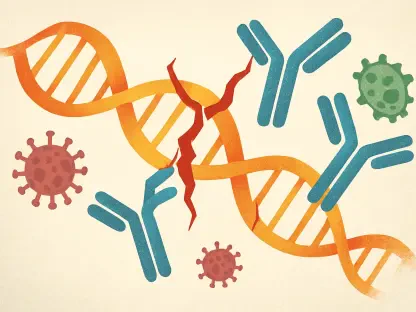The intricate relationship between the human gut and brain has emerged as a transformative area of study, particularly in understanding mental health challenges among children. Recent statistics reveal that anxiety disorders affect nearly one in five children, prompting researchers to explore underlying biological factors that may contribute to such conditions. A growing body of evidence points to the microbiome-gut-brain axis—a complex communication network linking gut bacteria with brain function—as a potential key player in emotional well-being, especially during the formative years of life.
This axis gains particular significance in early childhood, a period when both the gut microbiome and brain undergo rapid development. The first few years of life represent a critical window where microbial communities in the gut establish patterns that can influence neural pathways for years to come. Disruptions or imbalances during this stage may set the stage for later mental health issues, making it a focal point for scientific inquiry.
The central theme of this report delves into how toddler gut bacteria, specifically around the age of two, may shape the risk of anxiety in middle childhood. Drawing on cutting-edge research, this analysis explores the mechanisms behind this connection and its implications for child development, aiming to shed light on a previously underexplored dimension of mental health.
Understanding the Role of Gut Microbiota in Toddlerhood
Development and Diversity of Gut Bacteria in Early Life
Gut microbiota begins forming at birth, undergoing significant changes through infancy and stabilizing by the toddler years, roughly around ages two to three. During this phase, the microbial community evolves from a simple composition to a more complex, near-adult state, influenced by a variety of external factors. Diet, including the transition from breast milk to solid foods, plays a pivotal role in shaping microbial diversity, alongside environmental exposures such as household conditions and geographic location.
Additional influences like early life stressors, including maternal stress or antibiotic use, can alter the trajectory of microbial growth. These elements collectively determine the richness and variety of bacteria in the gut, which in turn may have downstream effects on physiological systems beyond digestion. Research indicates that a balanced and diverse microbial profile during this stage is crucial for overall health, setting a foundation that could impact mental well-being in later years.
Impact on Brain Development and Emotional Regulation
The interaction between gut bacteria and the brain occurs through the gut-brain axis, a bidirectional pathway involving neural, hormonal, and immune signals. Gut microbes produce metabolites and signaling molecules that can cross into the bloodstream, potentially influencing brain regions responsible for emotion and behavior. This communication is particularly impactful during early childhood when neural circuits related to stress response and emotional regulation are still forming.
Studies have shown that specific microbial profiles in toddlers correlate with variations in brain network connectivity, particularly in areas tied to mood and cognitive control. For instance, a higher presence of certain beneficial bacteria has been associated with enhanced development of neural pathways that manage emotional responses, suggesting that microbial health could act as a protective factor against mental health challenges as children grow.
Linking Toddler Gut Bacteria to Childhood Anxiety
Key Findings from Recent Research
Groundbreaking studies conducted in recent years have illuminated a compelling association between the gut microbiome in toddlers and internalizing symptoms, such as anxiety, by the time children reach school age, around seven to eight years old. Research highlights that specific bacterial groups, including Clostridiales and Lachnospiraceae, appear to play a role in these outcomes, potentially through mechanisms like inflammation triggered by early life adversities. These microbial taxa have been linked to variations in emotional health, pointing to a biological underpinning for anxiety risks.
The data suggests that the microbial environment at a young age leaves a lasting imprint on how children process emotions later in life. While the exact pathways remain under investigation, the presence or absence of certain bacteria during toddlerhood seems to correlate with the severity of anxiety symptoms observed years down the line, offering a novel perspective on mental health development.
Brain Connectivity as a Mediating Factor
Functional brain connectivity, assessed through advanced imaging techniques like functional magnetic resonance imaging, serves as a critical bridge between early gut microbiota and later anxiety symptoms. Specific brain networks, such as the fronto-parietal and default mode networks, which govern cognitive control and emotional processing, show distinct connectivity patterns that align with microbial profiles from toddlerhood. These signatures provide clues about how early biological factors influence mental health trajectories.
Research indicates that children with certain microbial compositions exhibit stronger or weaker connections in these brain regions, which in turn correlate with their ability to manage stress or anxiety. This mediating role of brain connectivity underscores the complexity of the gut-brain relationship, suggesting that early microbial health could shape neural architecture in ways that either protect against or predispose to emotional difficulties in middle childhood.
Challenges in Studying Gut Microbiota and Mental Health
The exploration of gut microbiota’s role in mental health is still in its early stages, grappling with several methodological hurdles. Small sample sizes in many studies limit the ability to draw broad conclusions, as findings may not fully represent diverse populations. Additionally, much of the current research remains exploratory, lacking the depth needed to confirm consistent patterns across different groups of children.
Establishing causation rather than mere correlation poses another significant challenge, as the gut-brain axis involves numerous variables that are difficult to isolate. Factors like genetics, parenting styles, and socioeconomic conditions intertwine with microbial influences, complicating efforts to pinpoint direct effects on anxiety. This complexity necessitates cautious interpretation of existing data while advocating for more robust research designs.
To address these gaps, there is a pressing need for larger, more inclusive studies that can validate preliminary findings and extend their applicability to clinical settings. Overcoming these barriers will be essential to translate early insights into actionable strategies for mental health care, ensuring that diverse childhood experiences are adequately represented in scientific conclusions.
Implications for Preventive Strategies and Interventions
Understanding the link between gut health and brain function opens up promising avenues for early interventions aimed at reducing anxiety risks in children. Dietary modifications, such as incorporating foods rich in prebiotics and probiotics, could foster a healthier microbial balance during toddlerhood, potentially mitigating the likelihood of emotional challenges later on. Such approaches offer a non-invasive way to support mental well-being from an early age.
Beyond diet, targeted interventions like microbial supplements or therapies might emerge as tools to address imbalances in gut bacteria linked to anxiety outcomes. These strategies, if proven effective through rigorous testing, could integrate into pediatric care, providing a proactive means to bolster emotional resilience before symptoms fully manifest in middle childhood.
However, implementing microbiome-based mental health strategies comes with ethical and practical challenges. Ensuring accessibility, avoiding over-medicalization of natural developmental processes, and addressing potential long-term effects of microbial interventions are critical considerations. Balancing innovation with caution will be key to responsibly harnessing these insights for child health benefits.
Future Directions in Gut Microbiota Research
Looking ahead, research on toddler gut bacteria and its impact on childhood anxiety is poised to advance with the integration of cutting-edge technologies like machine learning and high-resolution brain imaging. These tools can enhance the precision of microbial and neural mapping, uncovering deeper insights into how specific bacteria influence particular brain networks over time. Such advancements promise to refine the understanding of developmental mental health risks.
Emerging disruptors, including environmental shifts and novel microbial therapies, are likely to shape the trajectory of this field from 2025 to 2027 and beyond. Changes in global dietary habits or the introduction of engineered probiotics could alter microbial profiles on a population level, necessitating ongoing monitoring of their effects on child mental health. These factors highlight the dynamic nature of gut-brain research and its responsiveness to broader societal trends.
Integrating gut health into comprehensive developmental and psychological frameworks will be crucial for maximizing its relevance. Collaborations across disciplines—spanning microbiology, neuroscience, and child psychology—can ensure that findings translate into holistic approaches for supporting emotional growth, ultimately embedding microbial considerations into standard practices for child well-being.
Conclusion: Bridging Gut Health and Childhood Well-Being
Reflecting on the insights gathered, the exploration of toddler gut bacteria’s influence on childhood anxiety reveals a profound connection that reshapes perspectives on early development. The intricate interplay between microbial profiles and brain connectivity offers a new lens through which to view mental health challenges, emphasizing the enduring impact of early biological environments.
As a next step, stakeholders in child health and research communities are encouraged to prioritize longitudinal studies that track microbial and mental health outcomes across diverse populations. Investing in accessible interventions, such as community-based nutritional programs, emerges as a practical solution to support healthy gut development on a wider scale.
Looking beyond immediate findings, the potential to personalize mental health prevention through microbiome analysis stands out as a transformative consideration. By fostering partnerships between scientists, policymakers, and educators, the groundwork is laid for innovative strategies that could redefine how society nurtures emotional resilience in the youngest generations.









